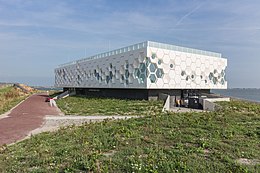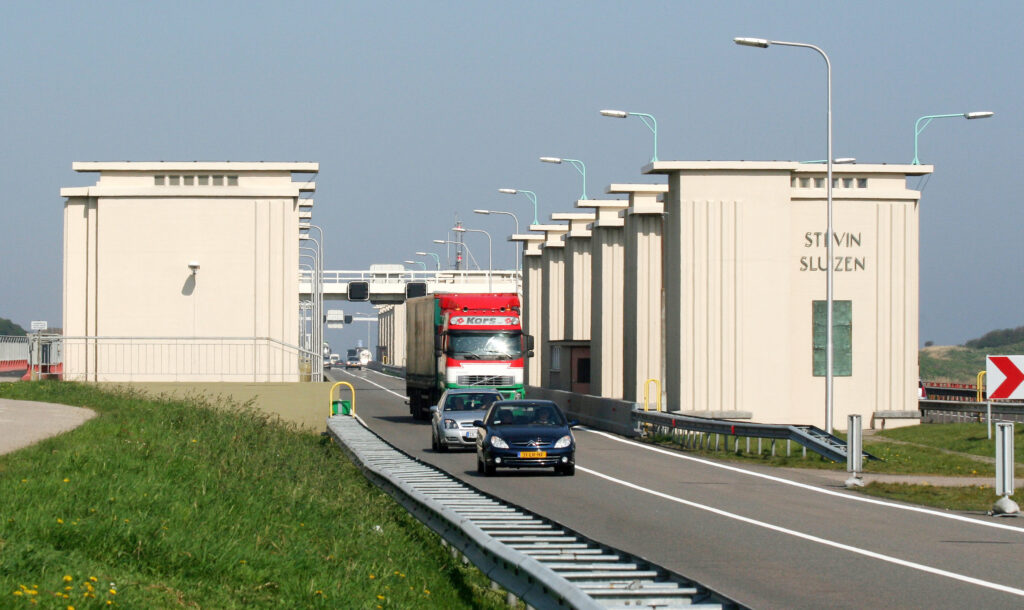Afsluitdijk

The Dutch backbone
The Afsluitdijk, a remarkable engineering marvel in the Netherlands, has been a symbol of Dutch water management and connectivity for nearly a century. Stretching 32 kilometers across the IJsselmeer, this monumental dike was completed in 1932 to protect the low-lying Dutch landscape from the ravages of the North Sea and to tame the Zuiderzee’s once-unpredictable waters.
Designed by visionary engineer Cornelis Lely, the Afsluitdijk not only serves as a robust flood defense system but also connects the provinces of North Holland and Friesland, revolutionizing transportation and trade in the region. Its roadway facilitates both vehicular and pedestrian traffic, fostering vital links between communities and supporting economic growth.
Over the years, the Afsluitdijk has undergone essential upgrades to adapt to changing environmental conditions and ensure its continued effectiveness. Rising sea levels due to climate change led to heightening the dike’s elevation, reinforcing its storm barriers, and safeguarding the hinterland from potential threats.
Moreover, the Afsluitdijk showcases the Netherlands’ commitment to sustainable innovation. As a potential source of renewable energy, the dike is being explored for harnessing tidal and solar power to provide clean electricity to nearby communities.
Today, the Afsluitdijk remains a testament to the Dutch spirit of ingenuity and resilience, a true national treasure that protects, connects, and inspires both the Dutch people and the world at large.

During WWII, Dutch soldiers held off German forces at the Afsluitdijk causeway for three days, giving their compatriots more time to counterattack.
Despite eventually surrendering due to limited ammunition and overwhelming forces, the site is now seen as a symbol of Dutch resistance. The Afsluitdijk, originally built for storm surge protection, now serves as a crucial part of Dutch infrastructure as a major road link and renewable energy project.
The Afsluitdijk Wadden Center is a modern visitor center on the famous dam separating the IJsselmeer and the Wadden Sea.
It offers an interactive experience showcasing the area’s history, architecture, and natural beauty. There are exhibits, a 4D tour, a rooftop terrace with panoramic views, and practical information about the area. It’s a great stop when traveling between North Holland and Friesland, easily accessible by car or bike, and offers a unique and educational experience for all ages.
The Stevin sluice in Den Oever is a remarkable feat of Dutch engineering that regulates water levels for flood prevention. The massive concrete doors, weighing 3,500 tons, use hydraulic pumps and motors to raise or lower depending on the water level. The sluice, part of the Dutch water management system, protects the country from flooding and is also a reminder of the ongoing threat of climate change.
The Afsluitdijk is a 32-kilometer dam built in the Netherlands between 1927 and 1932.
Its purpose was to protect low-lying areas from flooding and to create freshwater by turning saltwater into freshwater. The construction involved tens of thousands of workers and innovative engineering methods. It has a coastal road on top and two sluices to regulate water levels. These days, it still functions as a protective barrier against the sea and a source of freshwater.
The Afsluitdijk Tower is a visitors’ center located on a 32-kilometer-long Dutch dam built to prevent flooding in the country.
It was designed by Wouter Valkenier and completed in 2019. The tower offers an observation deck with a panoramic view, as well as exhibition space, a café, and a souvenir shop. It is also an example of sustainable architecture, using renewable energy sources and environmentally-friendly materials.
THE AFSLUITDIJK
The Afsluitdijk is important to protect all of the Netherlands against flooding.
The Afsluitdijk is part of the Delta Works. Construction started in 1927. In 1932 the last closing hole, the Vlieter, was closed.
There are locks for shipping and sluices on both sides of the Afsluitdijk. Against North Holland it is the Stevin locks. The Lorentz locks are located on Kornwerderzand, more than 4 km from Friesland. The entire dike is 32.5 km long, the water retaining part of it is 30 km. is the flood defense between North Holland and Friesland, which closes off the IJsselmeer from the Wadden Sea. This is where the dam gets its name.
FLOOD OF 1953
Spring tide and a northwesterly storm caused major flooding in the southwest of the Netherlands, Belgium and England in 1953.
The Afsluitdijk had a hard time, but held its own. As a result, floods around the IJsselmeer did not occur. Afterwards it was said that the Afsluitdijk had paid for itself in one night.
European walking route E9
The European walking route E9 runs across the dike, which is the North Sea Path or North Sea Trail. The E9 runs along the coast from Portugal to the Baltic Statesperformance lab
BICYCLE PATH CLOSED UNTIL END OF 2025
Afsluitdijk bicycle path closed, free bicycle bus deployed April 1, 2019 – end of 2025
During the works on the Afsluitdijk, safe cycling and walking on the Afsluitdijk will not be possible.














